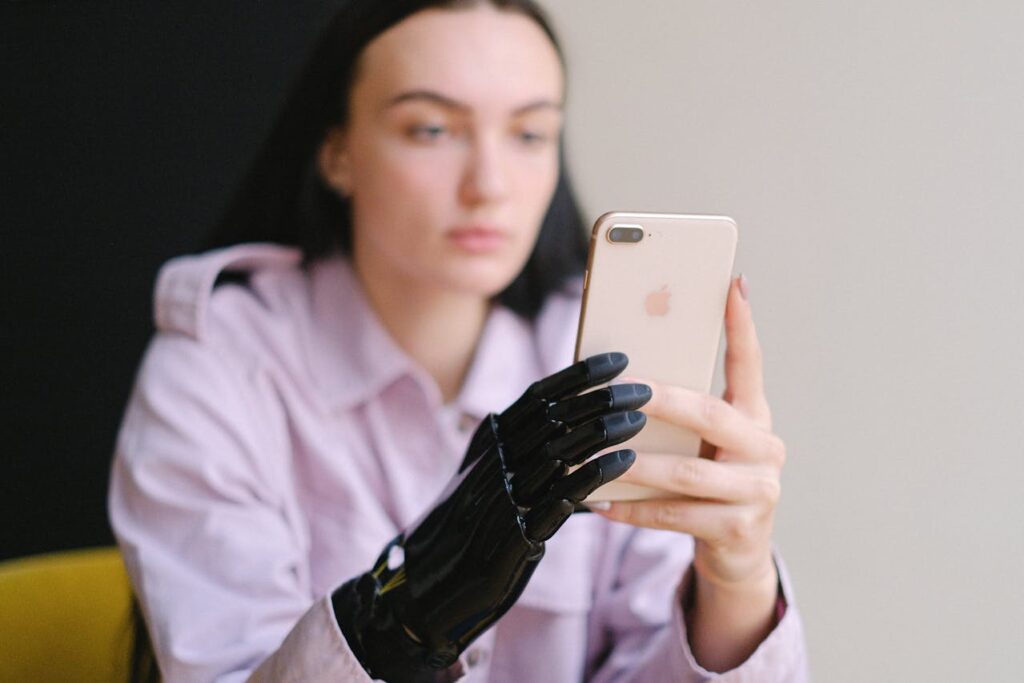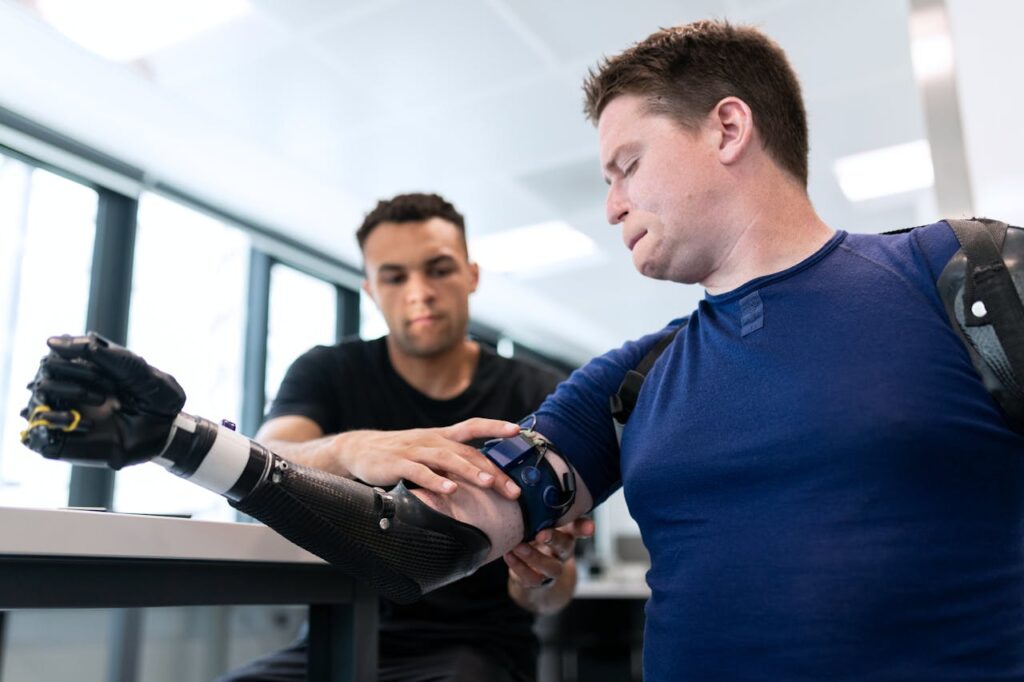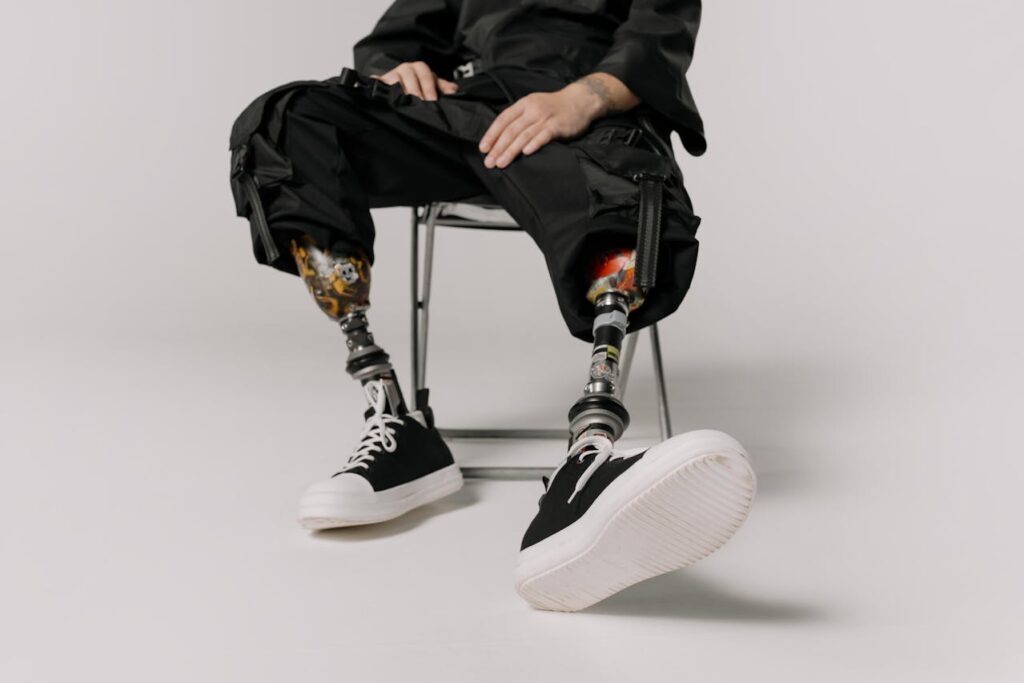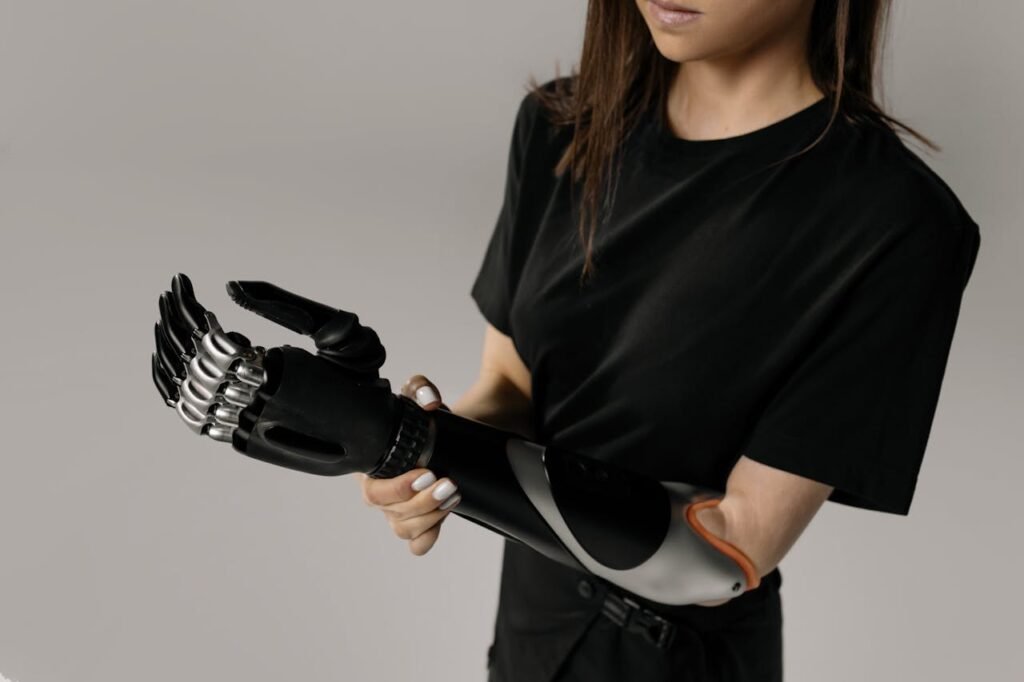Imagine a world where individuals with limb loss can control their prosthetics as effortlessly as they move their natural limbs, using only their thoughts. This is no longer the realm of science fiction—it’s a rapidly advancing field known as brain-controlled prosthetics. These devices promise to revolutionize mobility and independence, offering a seamless connection between mind and machine.
While the idea is groundbreaking, brain-controlled prosthetics are still in various stages of development. Scientists, engineers, and medical professionals are working tirelessly to overcome challenges and bring this technology to more people.
The Science Behind Brain-Controlled Prosthetics
Brain-controlled prosthetics, also known as neural-controlled prosthetics, rely on the brain’s natural electrical signals to operate. These signals, generated by neurons during thought or intention, can be captured and translated into commands that control a prosthetic limb. This direct connection between the brain and the device creates a more intuitive experience, mimicking the natural movement of biological limbs.
How It Works
The process begins with neural signals originating in the motor cortex, the area of the brain responsible for voluntary movements. These signals travel down the nervous system, but in individuals with limb loss, they no longer reach the intended muscles. Brain-controlled prosthetics intercept these signals, often using one of the following methods:
- Non-invasive systems: Electroencephalography (EEG) devices are placed on the scalp to detect brain activity. While non-invasive and convenient, these systems face challenges in signal accuracy and precision due to interference from other neural activity.
- Invasive systems: Microelectrodes are implanted directly into the brain to capture signals at their source. These systems offer greater precision but involve surgical procedures and potential risks.
- Peripheral nerve interfaces: Signals are captured from the remaining nerves in the residual limb. This approach is less invasive than direct brain implants but still provides detailed control over prosthetic movements.
Once captured, neural signals are processed by advanced algorithms that decode the user’s intention. These decoded signals are then sent to the prosthetic limb, activating motors and actuators to perform the desired movement.
For example, a user thinking about picking up a cup sends signals that the prosthetic interprets, allowing the hand to grip the object seamlessly.
Advancements in Signal Processing
The heart of brain-controlled prosthetics lies in signal processing—the ability to translate raw neural data into actionable commands. Recent advancements in machine learning and artificial intelligence have dramatically improved this process, enabling faster, more accurate interpretations of neural activity.
For instance, deep learning algorithms can identify patterns in neural signals, allowing prosthetics to predict movements with greater precision. This reduces the delay between intention and action, creating a more natural experience for the user.
At Robobionics, we believe that investing in smarter algorithms is key to unlocking the full potential of brain-controlled prosthetics. By collaborating with researchers in AI and neuroscience, we aim to make these devices more intuitive and user-friendly.

Current Progress and Real-World Applications
Brain-controlled prosthetics have moved from theoretical research to practical application in recent years. While the technology is not yet mainstream, several groundbreaking prototypes and trials have demonstrated its potential to transform lives.
These devices are proving their effectiveness in both clinical and real-world environments, showcasing what is possible when innovation meets human need.
Breakthrough Prototypes
One of the most well-known advancements in brain-controlled prosthetics is the development of robotic arms that offer multi-articulating movements controlled entirely by neural signals.
Prototypes like the DEKA Arm and the LUKE Arm have shown remarkable dexterity, allowing users to perform tasks such as picking up fragile objects or operating tools.
Another milestone is the creation of brain-controlled hands equipped with sensory feedback. These devices not only respond to user intent but also send tactile information back to the brain, enabling users to “feel” the objects they touch.
This bi-directional communication is a significant step toward making prosthetics feel like a natural extension of the body.
Clinical Trials and User Stories
Real-world applications of brain-controlled prosthetics are providing invaluable insights into their capabilities and limitations. Clinical trials with individuals who have undergone amputations or experienced paralysis have demonstrated the feasibility of these devices in restoring mobility and independence.
For example, a study involving brain-implant technology enabled a participant to control a robotic arm with thoughts alone, allowing them to perform everyday tasks like eating and drinking.
Another trial involving peripheral nerve interfaces showed users regaining the ability to perform complex hand movements, such as tying shoelaces or playing musical instruments.
These success stories highlight the transformative potential of brain-controlled prosthetics, while also underscoring the need for further refinement to improve usability and accessibility.
Addressing the Challenges
Despite the progress, brain-controlled prosthetics face several hurdles that must be overcome to make them widely available. These challenges span technical, financial, and social dimensions, requiring collaboration across industries to address effectively.
Technical Barriers
One of the primary challenges is achieving seamless communication between the brain and the prosthetic. Neural signals are inherently noisy, and distinguishing meaningful commands from background activity remains a complex task.
Advances in machine learning and signal processing are helping to mitigate these issues, but achieving consistent accuracy across diverse users is still a work in progress.

Additionally, the integration of sensory feedback systems adds another layer of complexity. Replicating the nuances of touch, pressure, and texture in a way that the brain can interpret accurately is a monumental task.
Current solutions, while promising, are still in their early stages and require significant refinement.
Financial and Accessibility Challenges
While brain-controlled prosthetics represent the cutting edge of assistive technology, their high cost remains a significant barrier to widespread adoption.
The advanced materials, sensors, neural interfaces, and processing systems required for these devices make them expensive to produce.
Additionally, the costs associated with surgical implantation for invasive systems and long-term maintenance can place them out of reach for many users.
Insurance coverage for brain-controlled prosthetics is still limited in most regions, as many insurers classify them as experimental or elective devices. This creates a financial burden for users who could benefit greatly from these advanced solutions but lack the resources to afford them.
Usability and Adaptation
While the technology behind brain-controlled prosthetics is impressive, ensuring ease of use is equally important. For many users, learning to operate a prosthetic through neural commands can be a steep learning curve.
Each individual’s neural patterns are unique, requiring customization and adaptation to align the device’s functionality with the user’s intent.
To address this challenge, businesses and developers are incorporating machine learning algorithms that allow prosthetics to “learn” and adapt to the user’s specific needs over time. These systems enable the device to become more intuitive, reducing the cognitive load required for operation.
Additionally, integrating user-friendly interfaces and providing robust training programs are essential steps in ensuring that users can fully benefit from brain-controlled prosthetics.
Partnerships with rehabilitation centers and occupational therapists can enhance the adoption process, making these devices more practical for everyday use.
The Road Ahead: Innovations on the Horizon
The future of brain-controlled prosthetics holds immense promise, with researchers and manufacturers exploring new frontiers in design, functionality, and accessibility. Several emerging technologies are poised to revolutionize the field and bring these devices closer to everyday reality.
Wireless and Wearable Systems
One area of active development is the transition from wired to wireless systems. Current invasive brain-controlled prosthetics often require a physical connection between the brain and the device, which can be cumbersome and limit mobility.
Wireless interfaces aim to eliminate this constraint, offering greater freedom and comfort for users.
Wearable systems that rely on external sensors to capture neural signals are also gaining traction. These devices, which use advanced imaging or non-invasive electrodes, could provide a more accessible option for users who prefer to avoid surgical implants.
Enhancing Neural Interfaces for Greater Precision
The core of brain-controlled prosthetics lies in the neural interface, the bridge between the user’s thoughts and the prosthetic device. Future developments aim to enhance the precision and responsiveness of these interfaces, making prosthetics feel like a natural extension of the body.
Research is moving toward interfaces capable of capturing more detailed neural signals, allowing for complex, multi-joint movements with minimal effort from the user.
Advances in bioengineering and material science are enabling the creation of flexible, biocompatible electrodes that seamlessly integrate with brain tissue or peripheral nerves, reducing the risk of rejection and improving signal fidelity.
Scaling Accessibility with Cost-Effective Solutions
One of the greatest challenges for brain-controlled prosthetics is their cost. Cutting-edge components, such as neural implants and AI-driven processors, drive up production expenses, making these devices inaccessible to many potential users.
The future of brain-controlled prosthetics depends on scaling accessibility through cost-effective manufacturing methods and innovative pricing models.
Businesses have the opportunity to explore modular designs that allow users to upgrade their devices incrementally, rather than investing in a completely new prosthetic.
Similarly, employing 3D printing technologies can reduce waste and production costs, making custom prosthetics more affordable. By focusing on scalable solutions, companies can tap into underserved markets and expand their reach while maintaining profitability.

Integrating AI for Smarter Prosthetics
Artificial intelligence is poised to play a transformative role in the future of brain-controlled prosthetics, making them smarter, more intuitive, and better at adapting to individual user needs.
AI-driven algorithms can analyze neural signals in real-time, predicting user intent with greater accuracy and speed.
The incorporation of adaptive learning systems allows prosthetics to “learn” a user’s unique neural patterns over time, improving responsiveness and reducing the cognitive effort required for operation.
Additionally, AI can enable prosthetics to anticipate complex movements, such as adjusting grip strength while holding an object or maintaining balance during dynamic activities.
Expanding Sensory Feedback Systems
The future of brain-controlled prosthetics includes a stronger focus on sensory feedback, enabling users to feel the objects they interact with and enhancing their connection to their environment.
Current systems provide basic sensations like pressure, but future advancements aim to replicate more complex sensory experiences, such as texture, temperature, and even pain (for safety purposes).
Innovative approaches, such as integrating bioelectronic interfaces and using advanced haptic technology, are paving the way for more nuanced feedback.
Businesses that develop prosthetics capable of bi-directional communication—where the brain sends commands and receives sensory input—will redefine the user experience.
Revolutionizing Brain-Controlled Prosthetics: Innovations and Opportunities
As researchers push the boundaries of what brain-controlled prosthetics can achieve, a new wave of innovations promises to address existing limitations and unlock transformative possibilities.
These advancements not only aim to refine the functionality and comfort of prosthetics but also focus on making the technology more accessible and integrated into everyday life.
Bi-Directional Communication: The Future of Sensory Feedback
The inclusion of sensory feedback systems in brain-controlled prosthetics represents a significant leap forward, but there is still much room for improvement. Current devices provide basic sensations like pressure and texture, but future iterations aim to replicate the full range of sensory experiences associated with natural limbs.
Emerging technologies, such as bioelectronic interfaces and advanced haptic systems, are making it possible to simulate more nuanced sensations, including temperature and vibration.
These innovations could enable users to feel the warmth of a cup of tea or the slight roughness of a pencil, enhancing their interaction with the environment.
Moreover, bi-directional communication between the brain and prosthetic could improve the device’s responsiveness and efficiency. By allowing the brain to receive sensory data and adjust commands in real time, these systems create a more natural and intuitive user experience.
Integration with Smart Ecosystems
Brain-controlled prosthetics are increasingly being designed to integrate seamlessly with smart technologies. Imagine a prosthetic hand that not only responds to neural commands but also connects to a smartphone, enabling users to adjust settings or monitor performance through an app.
This integration extends to home automation and wearable technology. Users could pair their prosthetics with smart home devices, allowing them to open doors, control appliances, or adjust lighting through neural commands.

These advancements align brain-controlled prosthetics with the broader trend of connected devices, making them more versatile and user-friendly.
For businesses, developing prosthetics compatible with smart ecosystems creates opportunities for partnerships with tech companies and positions their products at the forefront of innovation.
Scalability and Cost Reduction
One of the most pressing challenges for brain-controlled prosthetics is making them affordable for a wider audience. Scaling production through automation, 3D printing, and modular designs could significantly reduce manufacturing costs while maintaining quality.
For example, using 3D printing to create custom-fit components tailored to each user’s anatomy can streamline production and reduce waste. Modular designs allow for easy upgrades and repairs, extending the lifespan of the device and reducing long-term costs for users.
Collaborating with governments and non-profits to subsidize these devices or integrate them into public healthcare programs can also improve accessibility.
Businesses that prioritize affordability without compromising on quality will gain a competitive edge while expanding the market for brain-controlled prosthetics.
Overcoming Ethical and Social Barriers
As brain-controlled prosthetics become more advanced, ethical and social considerations must also be addressed. Questions around data privacy, long-term health impacts, and the potential for unequal access are central to the conversation.
For example, invasive systems that rely on brain implants raise concerns about the storage and use of neural data. Ensuring that users maintain control over their information is critical for building trust and encouraging adoption.
Data Privacy and Security
One of the most significant concerns with brain-controlled prosthetics, especially those using invasive systems, is the collection and management of neural data.
These devices capture sensitive brain signals that could potentially reveal patterns about a user’s thoughts or behaviors. Without proper safeguards, this data could be misused, raising serious ethical and privacy concerns.
To mitigate these risks, businesses must prioritize robust data security measures and transparency. Neural data should be encrypted, stored securely, and accessible only to the user and authorized personnel.
Clear policies on how data is collected, used, and retained are crucial for building trust. Additionally, businesses can empower users by giving them control over their data, including options to opt out of certain types of collection or usage.
For organizations, taking a proactive stance on data privacy not only addresses ethical concerns but also strengthens their reputation as responsible innovators in the field of assistive technology.
Inclusivity and Access
The potential for brain-controlled prosthetics to widen the gap between socio-economic groups is another pressing issue. Advanced technologies often come with high price tags, limiting access to wealthier individuals and leaving others behind.
This disparity raises questions about fairness and equity, particularly when the technology has the potential to transform lives so profoundly.
To address this challenge, businesses must commit to strategies that make brain-controlled prosthetics more accessible to underserved populations.
This can include developing cost-effective solutions, collaborating with governments to subsidize costs, or partnering with NGOs to distribute devices in low-income regions.
Advocating for public policies that prioritize equitable access to assistive technologies is also essential. By working with policymakers and healthcare organizations, businesses can help establish frameworks that ensure brain-controlled prosthetics are available to everyone, regardless of their financial situation.

Long-Term Health and Psychological Impacts
Invasive brain-controlled prosthetics, which involve surgical implants, come with inherent risks such as infection, device failure, or adverse neurological effects.
Users may also experience psychological challenges, including adapting to the prosthetic’s functionality or coping with the heightened awareness of their dependence on technology.
Addressing these concerns requires a user-centric approach that prioritizes safety, education, and support. Pre-implantation counseling can help users understand the risks and benefits of the technology, while post-implantation care should include regular monitoring and maintenance to address potential complications.
For businesses, providing resources such as user support groups, training sessions, and access to mental health professionals can ease the psychological burden on users and enhance their overall experience. These initiatives foster trust and demonstrate a commitment to holistic user well-being.
Navigating Ethical Boundaries
As brain-controlled prosthetics evolve, ethical questions about their potential uses and limitations are likely to arise.
Businesses developing brain-controlled prosthetics must engage in ongoing dialogue with ethicists, policymakers, and the public to navigate these complex questions.
Establishing clear boundaries and ethical guidelines ensures that the technology is used responsibly and aligns with societal values.
Building Public Trust
Ultimately, overcoming ethical and social barriers hinges on building public trust in brain-controlled prosthetics. Transparency, inclusivity, and responsible innovation are key to achieving this goal.
By demonstrating a commitment to user rights, safety, and equitable access, businesses can foster confidence in the technology and pave the way for its widespread adoption.
At Robobionics, we believe that technology should serve humanity, not the other way around. As we explore the possibilities of brain-controlled prosthetics, we are dedicated to addressing these challenges head-on, ensuring that our solutions empower users while upholding the highest ethical standards.

Conclusion
Brain-controlled prosthetics represent one of the most exciting advancements in assistive technology, offering a glimpse into a future where mobility and independence are seamlessly restored through the power of thought.
From the groundbreaking science behind neural interfaces to the real-world impact of prototypes and trials, this field is rapidly evolving, driven by relentless innovation and collaboration.
However, realizing the full potential of brain-controlled prosthetics requires addressing key challenges, from affordability and accessibility to ethical considerations and technical limitations.
By prioritizing inclusivity, user education, and robust data privacy, the industry can ensure these devices benefit individuals from all walks of life while upholding the highest standards of safety and equity.



